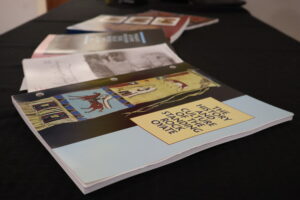Recent grad sees a gap in educational quality for tribal students
Survey shows many teachers unaware of resources on Native American history, culture

Shayla Davis, a member of the Mandan, Hidatsa and Arikara Nation and part of the Superintendent’s Student Cabinet, speaks before tribal educators at the 10th annual Indian Education Summit at the North Dakota Capitol in Bismarck on July 19, 2024. (Mary Steurer/North Dakota Monitor)
North Dakota tribal schools need better support — especially when it comes to serving low-income students, Shayla Davis, a member of Superintendent Kirsten Baesler’s Student Cabinet, told a crowd of tribal educators Friday.
“There should be no gaps in education,” Davis, a 2023 graduate of Devils Lake High School and member of the Mandan, Hidatsa and Arikara Nation, said.
Davis and other advocates for Native education gathered at the North Dakota Capitol on Thursday and Friday for the Department of Public Instruction’s 10th annual Indian Education Summit.
The two-day conference — which included speeches, presentations and breakout sessions — drew about 200 attendees, according to the Department of Public Instruction. The goal is to strengthen tribal education in North Dakota, according to the agency’s website.
For Davis, that means giving all students the opportunities they need to succeed. She said she could name more than 50 teachers that positively impacted her. But not all Native students in North Dakota have been as lucky, she said.
“I realized the socioeconomic challenges that were keeping other students just miles away from the same important educational opportunities we receive at Devils Lake High School — the same opportunities that truly made me the person that I am today,” Davis said.
She encouraged schools to find creative ways to serve students in need. She pointed to a Cass County nonprofit started in 2019 that created a school food and supply pantry for students.
“I believe that this can be done in tribal schools,” Davis said.
Davis also urged teachers to provide more opportunities for education on tribal history and culture.
“We must know who we are and where we come from,” she said.
Teachers and administrators that work in Native communities had similar feedback for the state, Ellie Shockley, a researcher for the North Dakota University System, said at a Friday breakout session.
Shockley worked with the Department of Public Instruction’s Indian and Multicultural Education Office to conduct the state’s 2023 survey on Native student needs.
The survey was taken by teachers and administrators at 35 North Dakota public schools with high Native populations, Shockley said. Overall, schools reported making an effort to engage with Native communities and to integrate tribal culture into the classroom, but still felt there was still considerable room for improvement.
“A number of respondents advocated for adding classes that enhance understanding of Native American culture,” Shockley said. She said the responses also highlighted issues faced by Native students, like school attendance and poverty.
“One bright spot is that respondents agree that Native American language instruction is commonly incorporated into daily and weekly activities,” Shockley said.
Schools seemed to be less familiar with state resources related to Native education, however.
The survey found just 50% of teachers and 72% of administrators were aware of the Department of Public Instructions’ Native American Essential Understandings project. The project, launched in 2015, works with Native elders to develop educational resources on Native history and culture in North Dakota.
The results also indicate schools may be struggling to implement a new requirement for K-12 schools to teach Native history adopted by the state Legislature in 2021. Shockley said just 75% of teachers and 89% of administrators were aware of the legislation. Much fewer — 57% of teachers and 67% of administrators — said they were aware of educational resources published by the North Dakota Department of Public Instruction related to the bill.

In a separate presentation, representatives from the Department of Public Instruction shared updates about an ongoing project to update a series of five ’90s-era textbooks on the history of North Dakota tribes.
Four of the textbooks focus on the Mandan, Hidatsa and Arikara Nation, Standing Rock Sioux Tribe, Turtle Mountain Band of Chippewa and Spirit Lake Nation, respectively. Another provides an introduction to the history of North Dakota Tribes. The series was authored by representatives of the tribes and published by the state roughly 30 years ago.
Lucy Fredericks, director of Indian and Multicultural Education for the Department of Public Instruction, is leading the effort to reprint the books in partnership with groups including the Indian Education Coalition, United Tribes Technical College, North Dakota State University and the University of North Dakota.
The Indian Education Coalition is currently working on making revisions to the textbooks, as well as writing about 30 pages of new material detailing the last three decades of each tribe’s history, Fredericks said. She said the books will be free to teachers and schools across the state.
“This definitely will be authentic, because it’s coming exactly from the tribes,” she said.
The project is funded by a grant through the federal CARES Act, said Fredericks.
The original textbooks did not include a history of the Sisseton-Wahpeton Oyate. Nick Asbury of the Department of Public Instruction said the agency would be open to adding another textbook dedicated to the tribe.






